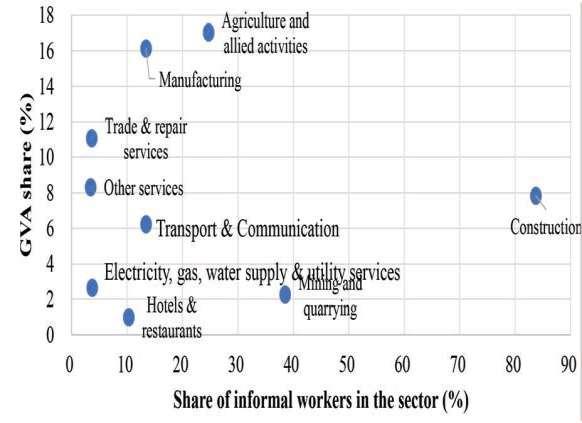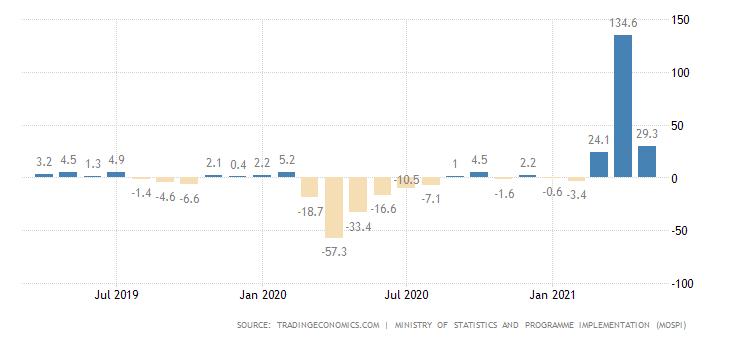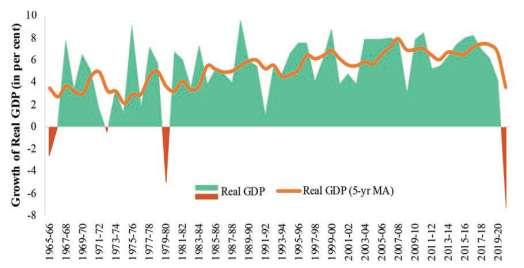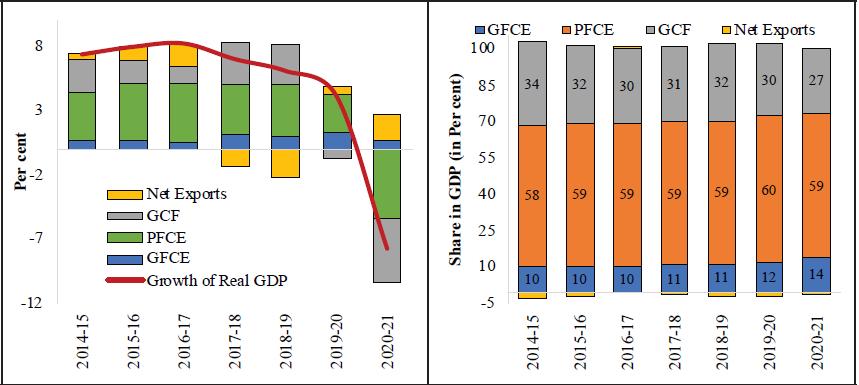Scholarly Research Journal for Interdisciplinary Studies, Online ISSN 2278-8808, SJIF 2021 = 7.380, www.srjis.com

PEER REVIEWED & REFEREED JOURNAL, NOV-DEC, 2022, VOL- 10/74
IMPACT OF COVID 19 ON INDIAN ECONOMIC DEVELOPMENT
Prof. Sabiya Shaikh1 & Prof. Dattatray Katore2
1Assistant Professor, Ajeenkya Dy Patil University Pune.
2Assistant Professor, Ajeenkya Dy Patil University Pune.
Paper Received On: 25 DECEMBER 2022
Peer Reviewed On: 31 DECEMBER 2022
Published On: 01 JANUARY 2023
Abstract
The world is currently undergoing repeated episodes of lockdown due to Covid 19 virus pandemic since from the first case detected in Wuhan city of China in December 2019. India being a developing country with world’s 17 percent population is not an exception to the Covid 19 virus spread and is one of the most severely affected countries in the world. India has witnessed repeated episodes of lockdown in response to recurring waves of Covid 19 spread. For a developing country like India which has world’s 17 percent population residing, the challenge is not only to save lives of people but to keep economic activities continue in order to provide employment to daily wage earners so that they can feed their families. Central government is also in need of financial resources in order to provide healthcare services and keep continuing other social and welfare schemes. The belligerent attitude of neighboring countries also pose different challenges and the government has to make huge expenditure on defense to face these challenges. In order to keep these necessities going, the economy has to keep growing at a steady rate. But lockdown has posed some serious challenges to keep economic activities going. This paper describe the impact of lockdowns on Indian industries in relation to various economic variables such as GDP, GNP, inflation, fiscal deficit, IIP etc.
Keywords: Covid19 Pandemic, Impact on industrial sector, Macroeconomic variables
Scholarly Research Journal's is licensed Based on a work at www.srjis.com
Introduction
The first case of Covid 19 virus was detected in Wuhan city of China in December 2019, since then the entire world is facing serious threat to lives as well as livelihood especially this part of the world which is characterized by large population, unemployment, poverty, scarcity of healthcare facilities, less per capita income etc. is greatly influenced. The first Covid19 case was detected in Kerala in late January 2020 following that Indian government introduced rigorous airport screenings for the corona virus (COVID-19). These
Copyright © 2022, Scholarly Research Journal for Interdisciplinary Studies
incidents are followed by a quick series of events which lead to a suspension and prohibition of all travel in and out of the country by March 22, 2020. A complete lockdown of 15 days was imposed on from March 2020. As the infections continued to increase The Covid 19 threat to India is not limited to lives of the people but also to the sustainability and growth of the economy. Over 17 percent of the world’s population is situated in the country, a large portion of which is below poverty line, the unemployment rate had been rising since last some years and is on peak high level which is a great threat to the Indian economy. The idleness of large portion of the resources may impose a recession and also a depression on the Indian economy. On the other hand Manufacturing activities also slowed down since from the series of lockdown and unlock and again lockdown which started on 23rd March 2020. Recently media reported that the sales of automobile sector have fallen down to half as compared to that of year 2020. Even after 32 crores of people getting vaccines future is uncertain as the virus is reported to mutate to create new variants of itself. The developing Indian economy has to fight on different fronts like providing healthcare facilities to all the population, continuing social and welfare schemes as work of welfare nation, keep investing on defense due to belligerent and aggressive neighbors, keep continuing major infrastructure project to provide employment to daily wage earners. On the contrary shutting manufacturing due lockdown and also due lack of aggregate demand may start the vicious cycle of poverty, unemployment and finally recession. Lack of overall economic activities may erode the government’s sources of revenue and the government will not be in position to meet all of the challenged mentioned above in this paragraph.
Twin economic shock of Demand and Supply
The unique economic surprise brought forward by the pandemic is that it has triggered both demand and supply side shocks simultaneously across almost all the world economies. The first order demand shock is caused by substantial decrease in consumption and investment, The decrease in investment and consumption is caused by decreased confidence, reduced incomes, uncertainty, fear of contagion, reduced spending options due to lockdown induced closure of the contact involving activities, weaker growth prospects, risk aversion among the corporate firms and businesses. But this is the only one side of the story, the economic shock is dual in nature. The supply side is also disrupted by many unwanted reasons.
The first level of supply side disruptions caused second round of disruptions on both supply and demand. The starting supply shock which caused wage and income loss, could
Copyright © 2022, Scholarly Research Journal for Interdisciplinary Studies
impact aggregate demand and disturb productive capacity leading to supply sequential shocks. These series of effects were further boosted through international business trade and financial linkages which dampened global economic activity pushing commodity prices down. The subsequent loops of demand and supply created potential hysteresis effects - when households demand weakened, firms started getting reduced revenues, which triggered reduced manufacturing activity by firms, and thus decreased household income.
The intensity and spread of COVID-19 resulted into a twin economic shock which can be broadly captured through impact on output i.e. Gross Value Added (GVA) and employment. In terms of output or gross value added (GVA) shock, non-essential activities are likely to bear a joint shock directly proportional to their respective gross value added (GVA) contribution, given that they could not work during the pandemic caused lockdown. Essential activities are expected to have a dampened shock, mainly arising from the indirect impact of closed activities in non-essential sectors. In terms of employment shock, contact involving sectors like trade, hotels, transport, tourism, etc. are expected to have a shock directly proportional to the respective employment share, with informal workers working in unorganized sectors expected to have the larger brunt.
The pandemic caused wide spread implications and uncertainty on all types and aspects of businesses across the world. In spite of India being ahead of most of the countries to implement work-from-home measures, especially in white collar jobs and work and earning deficits, along with instability in prices was expected. The weeks of the lockdown resulted in the continuous decrease in employment, which slowly improved after the economy steadied in most parts of the country.
But the second wave surprisingly spread panic across the country and the economy which was supposed to be stabilizing again had a major setback. Prediction are also being made about the third wave of the Covid19 to hit back in September 2021. Economic activity started to take a hit yet again since March 2021, as the second wave of Covid 19 pandemic hit the country. As a consequence, GDP estimations were expected to fall, pushing losses at over 38 billion U.S. dollars if local lockdowns continued till July 2021. Unexpected and unprecedented record numbers in terms of infections and deaths were recorded in the country led to another set of lockdowns in some parts, putting pressure on the healthcare system amidst the government controversy. International help in the form of oxygen cylinders, PPE kits, ventilators along with funding was being provided from various countries to what looked
Copyright © 2022, Scholarly Research Journal for Interdisciplinary Studies
like a terrible situation. Predictions are also being made about the third wave of the Covid19 to hit back in September 2021. A detailed analysis is thus needed to understand and measure the impact of Covid 19 pandemic on overall economic activity. The overall economic activity in return can be judged from various macroeconomic variable and indicators such as IIP, GDP, unemployment rate etc. This paper relies on government reports and surveys primarily for the data with respect GDP growth rate, unemployment, inflations, sector wise losses etc.
Review of Literature
Barbate Vikas, Rajesh Gade and Shirish Raibagkar (2021), ‘COVID-19 and Its Impact on the Indian Economy’. Authors concluded that there will be large scale impact on the growth rate in the short period, inflation can also rise in the short run. Output and revenue of most of the sector has fallen as compared to that of previous year. Authors predicted that long run Covid19 impact will depend upon recovery mode.
Dr. Kishor Kumar Das and Shalini Patnaik June 2020, ‘The Impact of COVID-19 in Indian Economy – An Empirical Study’Authors concluded that there will be deep and adverse impact on Indian businesses and there might be economic slowdown and recession is also possible.
Chaudhary Monika, Sodani and Shankar Das, August 2020, in their research paper titled ‘Effect of COVID-19 on Economy in India: Some Reflections for Policy and Program’. Concluded that there has been adverse short term effect on economic growth and development the ill effects will take some time to perish.
Shubhi Agarwal, Archna Singh February 2020, ‘Covid-19 and Its Impact on Indian Economy’. Aviation, Hospitality, and Tourism are the worst suffered sectors that are having the maximum brunt of the present pandemic Covid-19. Due to the lockdown effect, the closing of shopping malls and other public amusement and entertainment activities has severely affected the consumer retail sector by reducing the consumption of essentials and entertainment purposes goods. There is a decrease in the level of income, particularly that of daily wage earners due to slow economic activities in many sectors like retails, constructions, transport, and entertainment, etc. that ultimately lead to fall in consumption front.
Copyright © 2022, Scholarly Research Journal for Interdisciplinary Studies
Research Methodology
Research Objectives
1. To assess the impact of Covid 19 pandemic on Indian economy in short run
2. To predict the long run trends in Indian economy.
3. To analyze the inter-temporal changes in various macroeconomic variables and aggregates.
4. To study the various policy measures undertaken by the government for revival.
Research Methods
This is a descriptive research paper, an ex-post facto research with no control over the variables. The research tries to report what has happened and what is happening with regards to Indian economy due to Covid 19 pandemic. The research methods used in this paper are analysis of historical records and documents. The research techniques such as statistical compilations and manipulation, content analysis etc. have been used. This paper is based on secondary data and various government reports, publications, Economic survey etc.
Data Collection
The research is based upon secondary data collected from various reports, websites and publications of government. The data is collected from economic surveys of India, Websites of SEBI, CBDT, https://data.gov.in https://www.pib.gov.in Error! Hyperlink reference not valid.Statistical tools and techniques
Statistical Techniques-In this research below mentioned simple statistical techniques are used
1. Time Series Analysis
2. Trend Analysis
3. Ratios
4. Descriptive statistical measures of central tendency and measures of dispersion. Data Analysis and Interpretation
Copyright © 2022, Scholarly Research Journal for Interdisciplinary Studies
Source-Ministry of Statistics and program implementation, PLFS 2018-19, NSO
Construction is the sector which employs highest share of informal laborers, daily wage workers and is greatly impacted as compared to some other sectors. Initial lockdown caused unemployment in this sector which resulted in migration of laborers working in construction sector to their native places.

The manufacturing sector was affected adversely in the first quarter but has picked up though mining still remaining sectors are impacted. Construction and Services sectors were impacted the worst due to the pandemic induced requirements of social distancing and minimizing of personal contact. Agriculture sector comparatively remained immune to the COVID 19 impact because of timely and proactive exemptions to the lockdown which resulted in uninterrupted harvesting and sowing of Rabi and Kharip crops respectively. However transportations and logistics disruption affected the supply of agricultural good which resulted in initial decrease in agricultural exports and high inflation.
IIP( Index of Industrial production)
The estimates of Index of Industrial Production (IIP) at the base year 2011-12 prices for the month of May 2021, showed that the index at constant prices stood at 116.6. This resulted in a 29.3% jump compared to the lockdown affected May 2020. The Indices of Industrial Production at constant prices for the electricity, mining and Manufacturing sectors for May 2021 stood at 161.9, 113.5 and 108.0 respectively. The increase in the Industrial production of 29.3 per cent in May 2021 of this year is mainly due to a low base of last year lockdown affected figures and better performance by manufacturing, mining and power sectors, but it still remained below the pre-lockdown level. The manufacturing sector which
Copyright © 2022, Scholarly Research Journal for Interdisciplinary Studies
is the largest constituent of IIP and constitutes for 77.63 percent in the Index of Industrial Production (IIP) at constant prices increased 34.5 per cent in May 2021 this year. Trend in IIP (percentage increase over same month of previous year)

Chart Title
The IIP percentage change over previous year shown is illusionary, as it is inflated because of the base year effect. Even the government also suggested that the previous year’s IIP data could not be used for drawing conclusion regarding the growth in industrial production. A more clear picture can be seen when we take IIP data of a larger horizon as shown in figure above. Clearly the curve has started a lower trajectory due to the impact of Covid19. The increase of 23.4% over the previous year is thus unsatisfactory as well as illusionary.
Copyright © 2022, Scholarly Research Journal for Interdisciplinary Studies
WPI (percentage change over the same month of previous year)
GDP Quarterly growth rate


Source- Economic Survey of India 2020-21 vol.2 India’s GDP contracted by 23.9 per cent in Q1: FY 2020-21 and 7.5 per cent in Q2: FY 2020-21 quarter reflected the unparalleled effect of the Covid-19 pandemic The contraction was consistent with the government’s enforcement of one of the most stringent lockdowns in the world. NSO has estimated a fall of India’s real GDP by 7.7 per cent in 2020-21 as compared to a growth of 4.2 per cent in 2019-20.
Copyright © 2022, Scholarly Research Journal for Interdisciplinary Studies

The Indian economy has grown at a rate of 1.6% in Q1 of 2021, accelerating from an upwardly revised 0.5% growth in Q4 and beating market forecasts of 1%. It was the 2nd back to back quarter of growth since the country exit a lockdown induced recession. On the expenditure side, both public spending and private consumption rebounded while gross capital formation increased faster. Meanwhile, the net trade contributed negatively to the growth as the exports rose 8.8% (vs -3.5% in Q4) but imports jumped at even faster rate of 12.3% (vs -5% in Q4). On the other side on the production side, output (GVA) also increased. In the last financial year that ended on March 31st 2021, the economy shrunk a record 7.3%, less than earlier forecasts of an 8% drop. Asia’s 3rd largest economy is supposed to grow at the fastest rate this year despite projections for the current quarter being more pessimistic amidst the 2nd wave of infections in April 2021.

CPI- (A measure of inflation in consumer goods)
Copyright © 2022, Scholarly Research Journal for Interdisciplinary Studies

A major driver of inflation in year 2020 is the high food prices. But the inflation was tempoarary as in December, 2020 it fell again into the Reserve bank’s target limit of 4 +/- 2 per cent to reach 4.6 percent as compared to 6.9 percent in November 2020. This was mainly caused by a steep decrease in food prices, particularly of vegetables, cereals, and protein products and again a favorable base effects of lower prices. After continuously rising for almost six months since Q1 of 2020-21, headline inflation rate i.e. consumer price index also decreased sequentially in the December of 2020.
NSO has forecasted a decrease of real GDP by 7.7 per cent in the year 2020-21 as compared to a growth rate of 4.2 per cent in the year 2019-20. This is the fourth largest reduction in the history of India's GDP since 1960-61. Government Consumption and Net Exports have to some extent decreased the reduction in the GDP while Private Consumption and Gross Capital Formation (GCF) have contributed to the decrease in GDP in the year 2020-21
Government consumption spending has sustained the growth of GDP in 2020-21 with its share rising to 14 percent from 12 percent in the year 2019-20. The contribution of private consumption has almost remained unchanged indicating the negative impact of the pandemic and controlled private consumption in contact involving sectors. Investment has contributed significantly to the fall in GDP in 2020-21 with its contribution in GDP marked at 26.7 per cent. But Net Exports have cushioned the fall in GDP in 2020-21 largely due to a sharper fall in imports than in exports.
Conclusion and Discussion
India’s GDP is estimated to decrease by 7.7 per cent in 2021, because of a sharp 15.7 per cent decline in first half of the financial year and a modest 0.1 per cent fall in the second
Copyright © 2022, Scholarly Research Journal for Interdisciplinary Studies

half of the financial year 2020-21. Sector-wise, agriculture has remained immune from the pandemic thanks to the adequate rainfall. It remained the silver lining but contact involving sectors such as services, manufacturing, and construction were affected badly, and they have been recovering slowly. Government spending and net exports have cushioned the growth to some extent from diving further down.
The V shaped economic revival is supported by the start of a large vaccination driveby the government with hopes of a fast and robust revival in the services sector. Together, hopes for the robust growth in consumption and investment have been reestablished with the estimated real GDP growth for FY 2021-22 at 11 per cent.
India’s GDP fall of 23.9 per cent in Q1 of the financial year 2020-21 and 7.5 per cent in Q2 of the financial year 2020-21 reflects the effect of the Covid-19 pandemic induced lockdown and the containment actions that were taken to manage the epidemic The null hypothesis that there is no impact on Indian economy due to covid19 pandemic is rejected and we have to conclude that there is significant impact of Covid19 on growth and development of Indian economy.
Though the impact was severe and adverse, there are some early signs of recovery, most of the macroeconomic indicators have shown strong and robust recovery and economists and government is hoping for a V-shape recovery. The analysis could not cover the impact of third wave because unavailability of data. The second wave and third wave are expected to be more severe and will determine the future. Still It can be said that the economy is fundamentally strong and has potential to recover sharply once the world is free from Covid19 virus.
References
(WHO), reports on Coronavirus disease (COVID-2019) situation reports.
Macroeconomic Analysis- Edward Shapiro
Periodic labour force survey (PLFS) 2018-19 conducted by National Statistical Office, published by Ministry of statistics and programme implementation.
Economic Survey of India 2020-21, Ministry of finance, Department of economic affairs, Government of India.
Copyright © 2022, Scholarly Research Journal for Interdisciplinary Studies
